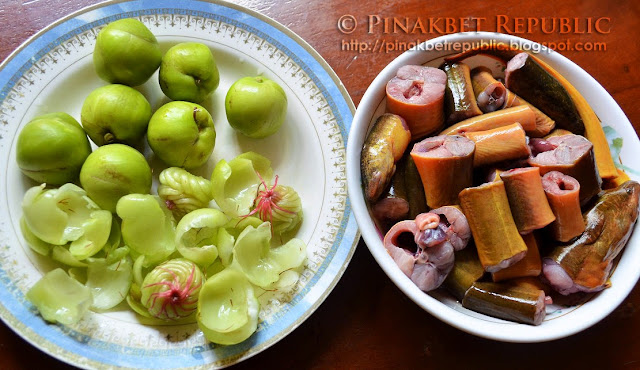Igat (eel, palos) is unusually abundant these days in Cagayan Valley (Region
2, Philippines), what with a reported one ton daily export to countries who
relish this rather slimy but very tasty fish, especially the Japanese, Chinese,
Koreans. And these are eels gathered in the rice paddies in the region, mostly
growing wild. A kind of small eel called kiwet
is even considered now as a pest in the ricefields in the valley, especially in
Nueva Vizcaya and Isabela, because this eel burrow and bore in the soil, making
holes and thus draining the rice paddies. Farmers gather it as a delicacy
though and one of the preferred way of cooking it is deep frying it in oil to
make it crispy and crunchy.
Some
do not like eels because of its distinct sliminess and overwhelming langsi or lang-es (fishy stench, lansa).
But proper cleaning and cooking can rid these and turn it into a very tasty
fish dish, like adobo, paksiw, even sinigang (sour soup). It can also simply
be grilled. And it’s perfect for tapa or daing (sun-dried, salted or smoked).
 |
| Eel adobo soured with palali fruit. |
One
Sunday morning, I saw these gorgeous eels for sale along the highway in Iguig,
Cagayan. Live eels in various sizes still wriggling. I was told these were
caught in the nearby Cagayan River, unusually larger than the known kiwet variety that thrives in the rice fields (but I was later informed that this is the same kiwet, anyway). I bought one stringful of three eels for PhP100.
I like to think it’s a bargain. These are kind of exotic fish and is prized by
some gourmands who claim it’s an aphrodisiac food and therefore insanely
expensive in some countries:
I
cut and cleaned the eels, repeatedly rinsed it in water to get rid of the slime
and draining all its blood thoroughly (kiwet it really is because of its unusual sliminess!):
I
intend to cook it into an adobo, dry and
a bit salty stew which is just apt for the firm texture of this fish. I decided
not to use vinegar as a souring agent and instead opted to use palali (catmon) fruit:
I
cooked my adobo nga igat in slow fire
for all the flavors and spices (soy sauce, garlic, black peppercorn) and
sourness to seep in. As it cooks, the fish will literally ooze its fat:
Simmered
into a dry, palali-soured adobo, the igat is here rendered phenomenally tasty and delicious, I say that
the the palali fruit as a souring
agent further removed the fishy smell than a vinegar can, adding more flavor
into the delicate but firm eel flesh:
~~~~~
::::::























0 comments:
Post a Comment